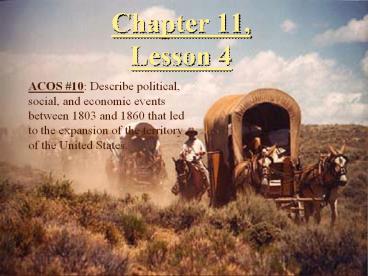Chapter 11, Lesson 4 - PowerPoint PPT Presentation
Title:
Chapter 11, Lesson 4
Description:
One woman described the trail in her journal: Not a drop of water, nor a spear of grass to be seen, nothing but barren hills, bare and broken rock, sand and dust. – PowerPoint PPT presentation
Number of Views:87
Avg rating:3.0/5.0
Title: Chapter 11, Lesson 4
1
Chapter 11,Lesson 4
ACOS 10 Describe political, social, and
economic events between 1803 and 1860 that led to
the expansion of the territory of the United
States.
2
Key Vocabulary Words
- Wagon train a line of covered wagons that moved
together across the country. - Forty-niner a person who went to look for gold
in California around 1849. - Gold rush the quick movement of people to
California and other places following the
discovery of gold. - Boomtown a town offering many chances to make
money and filled with people just arriving. A
town that grows, or booms, very quickly.
3
Trails West
- In 1824, Crow Indians showed a trapper a way
through the Rocky Mountains that was wide enough
for wagons. - The route was called the South Pass.
- By the end of the 1850s, thousands of people had
traveled through the South Pass on a route know
as the Oregon Trail. - The Oregon Trail was about 2,000 miles long.
- It started in Missouri and stretched west across
the Rocky Mountains to present day Oregon.
4
Oregon Trail
5
- Marcus and Narcissa Whitman were two of the first
pioneers to travel to Oregon. - They were missionaries who wanted to teach
American Indians about Christianity. - The Whitman mission became a place where
travelers could rest. - John Frémont explored parts of the west and
helped make maps of the Oregon Trail. - He wrote reports describing the beautiful land.
- People on the Oregon Trail used Frémonts maps
and reports as guides.
6
Wagon Trains
- The first large group of about
1,000 people set out on
the Oregon
Trail in 1873. - They came from Ohio, Indiana,
Illinois, Kentucky, and
Tennessee. - They were looking for good,
inexpensive land. - Pioneers traveled by wagon train.
- A wagon train was a line of covered wagons that
moved together. - Oxen, mules, or horses pulled the wagons.
7
- Travelers on the Oregon Trail faced injuries,
diseases, bad weather, lack of food, and water. - One woman described the trail in her journal
- Not a drop of water, nor a spear of grass to be
seen, nothing but barren hills, bare and broken
rock, sand and dust. - Despite the hardships, many people settled in
Oregon. - President Polk wanted Oregon to belong to the
United States. - At the time, Oregon was claimed by both the
United States and Britain. - In 1846, President Polk signed a treaty with
Britain to set the border between the United
States and Canada. - In 1848, this land became the Oregon Territory.
8
- Pioneers took other trails to the west.
- Some people traveled on the Mormon Trail were
members of the Latter-Day Saints Church, founded
in New York in 1830. These people were called
Mormons. - Some people did not like the Mormons beliefs and
would not let them practice their religion. - In 1847, Brigham Young, a Mormon leader, took his
people west to present-day Utah.
9
The Oregon Trail
- The Oregon Trail Video
10
The California Gold Rush
- Before the 1700s, California Indians lived in
villages where they hunted, gathered plants, and
fished. - When California became part of New Spain, many
Indians were forced to live on missions. - When Mexico gained independence, California
became part of it. - The Mexican citizens built large ranches and
forced American Indians to work on these ranches. - In 1848 when California joined the United States,
the people became U. S. citizens. - Very little changed for American Indians.
11
The California Gold Rush
- Gold was discovered in California that same year.
- Thousands of people from the United States,
Mexico, China, Europe, and South America rushed
to California to dig for gold. - These people became know as the forty-niners.
- A forty-niner was a miner who went to California
around 1849. - More than 250,000 people went to California to
look for gold. - A gold rush takes place when many people hurry to
the same area to look for gold. - Boomtowns sprang up near the gold mines.
- A boomtown is a town whose population booms, or
grows very quickly.
12
After the Gold Rush
- The California Gold Rush lasted about 5 years.
- Only a few people actually found gold.
- Some forty-niners went back home, but thousands
stayed and settled in California. - The Gold Rush changed California.
- Miners and farmers killed California Indians and
took their land. - Newcomers forced many property owners off their
land. - Cities grew.
- California became a state.
- Can watch Gold Rush video 2512 minutes
13
Test Question
- How did the California Gold Rush change the lives
of many Californios? - Californio property owners were forced off
their land.































